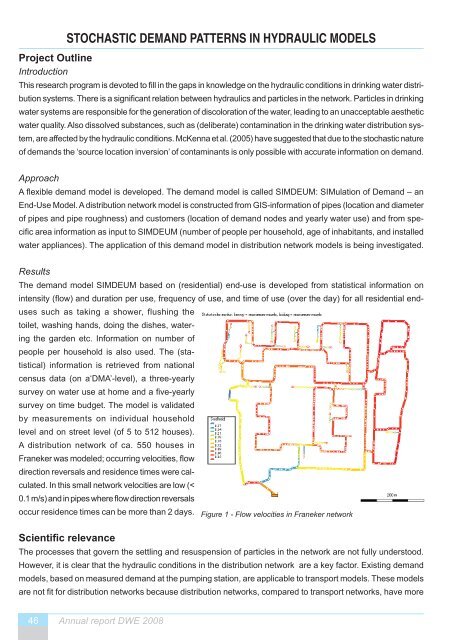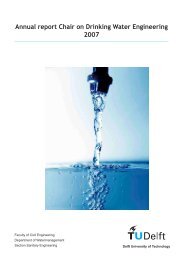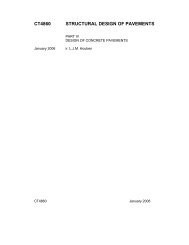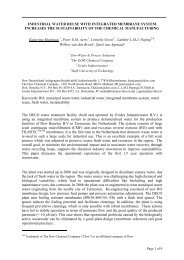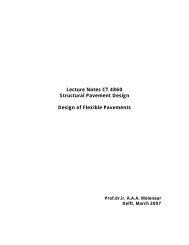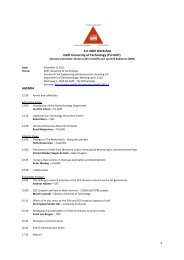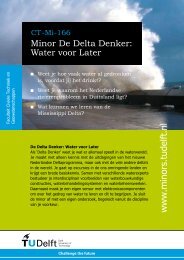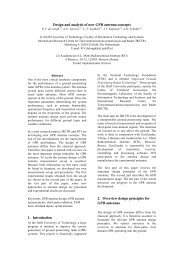Annual report Chair on Drinking Water Engineering 2008 - TU Delft
Annual report Chair on Drinking Water Engineering 2008 - TU Delft
Annual report Chair on Drinking Water Engineering 2008 - TU Delft
You also want an ePaper? Increase the reach of your titles
YUMPU automatically turns print PDFs into web optimized ePapers that Google loves.
Project Outline<br />
Introducti<strong>on</strong><br />
stochastic deMand Patterns in hydraulic Models<br />
This research program is devoted to fill in the gaps in knowledge <strong>on</strong> the hydraulic c<strong>on</strong>diti<strong>on</strong>s in drinking water distri-<br />
buti<strong>on</strong> systems. There is a significant relati<strong>on</strong> between hydraulics and particles in the network. Particles in drinking<br />
water systems are resp<strong>on</strong>sible for the generati<strong>on</strong> of discolorati<strong>on</strong> of the water, leading to an unacceptable aesthetic<br />
water quality. Also dissolved substances, such as (deliberate) c<strong>on</strong>taminati<strong>on</strong> in the drinking water distributi<strong>on</strong> system,<br />
are affected by the hydraulic c<strong>on</strong>diti<strong>on</strong>s. McKenna et al. (2005) have suggested that due to the stochastic nature<br />
of demands the ‘source locati<strong>on</strong> inversi<strong>on</strong>’ of c<strong>on</strong>taminants is <strong>on</strong>ly possible with accurate informati<strong>on</strong> <strong>on</strong> demand.<br />
Approach<br />
A flexible demand model is developed. The demand model is called SIMDEUM: SIMulati<strong>on</strong> of Demand – an<br />
End-Use Model. A distributi<strong>on</strong> network model is c<strong>on</strong>structed from GIS-informati<strong>on</strong> of pipes (locati<strong>on</strong> and diameter<br />
of pipes and pipe roughness) and customers (locati<strong>on</strong> of demand nodes and yearly water use) and from specific<br />
area informati<strong>on</strong> as input to SIMDEUM (number of people per household, age of inhabitants, and installed<br />
water appliances). The applicati<strong>on</strong> of this demand model in distributi<strong>on</strong> network models is being investigated.<br />
Results<br />
The demand model SIMDEUM based <strong>on</strong> (residential) end-use is developed from statistical informati<strong>on</strong> <strong>on</strong><br />
intensity (flow) and durati<strong>on</strong> per use, frequency of use, and time of use (over the day) for all residential enduses<br />
such as taking a shower, flushing the<br />
toilet, washing hands, doing the dishes, watering<br />
the garden etc. Informati<strong>on</strong> <strong>on</strong> number of<br />
people per household is also used. The (statistical)<br />
informati<strong>on</strong> is retrieved from nati<strong>on</strong>al<br />
census data (<strong>on</strong> a‘DMA’-level), a three-yearly<br />
survey <strong>on</strong> water use at home and a five-yearly<br />
survey <strong>on</strong> time budget. The model is validated<br />
by measurements <strong>on</strong> individual household<br />
level and <strong>on</strong> street level (of 5 to 512 houses).<br />
A distributi<strong>on</strong> network of ca. 550 houses in<br />
Franeker was modeled; occurring velocities, flow<br />
directi<strong>on</strong> reversals and residence times were calculated.<br />
In this small network velocities are low (<<br />
0.1 m/s) and in pipes where flow directi<strong>on</strong> reversals<br />
occur residence times can be more than 2 days. Figure 1 - Flow velocities in Franeker network<br />
Scientific relevance<br />
The processes that govern the settling and resuspensi<strong>on</strong> of particles in the network are not fully understood.<br />
However, it is clear that the hydraulic c<strong>on</strong>diti<strong>on</strong>s in the distributi<strong>on</strong> network are a key factor. Existing demand<br />
models, based <strong>on</strong> measured demand at the pumping stati<strong>on</strong>, are applicable to transport models. These models<br />
are not fit for distributi<strong>on</strong> networks because distributi<strong>on</strong> networks, compared to transport networks, have more<br />
46 <str<strong>on</strong>g>Annual</str<strong>on</strong>g> <str<strong>on</strong>g>report</str<strong>on</strong>g> DWE <strong>2008</strong>


